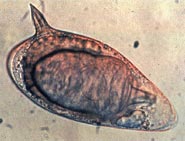
Photo from wikipedia
Cercarial emission of schistosomes is a determinant in the transmission to the definitive host and constitutes a good marker to identify which definitive host is responsible for transmission, mainly in… Click to show full abstract
Cercarial emission of schistosomes is a determinant in the transmission to the definitive host and constitutes a good marker to identify which definitive host is responsible for transmission, mainly in introgressive hybridization situations. Our goal was to test the hypothesis that micro-mammals play a role in Schistosoma haematobium, S. bovis, and/or S. haematobium x S. bovis transmission. Small mammal sampling was conducted in seven semi-lacustrine villages of southern Benin. Among the 62 animals trapped, 50 individuals were investigated for Schistosoma adults and eggs: 37 Rattus rattus, 3 Rattus norvegicus, 9 Mastomys natalensis, and 1 Crocidura olivieri. Schistosoma adults were found in four R. rattus and two M. natalensis, with a local prevalence reaching 80% and 50%, respectively. Two cercarial chronotypes were found from Bulinus globosus experimentally infected with miracidia extracted from naturally infected M. natalensis: a late diurnal and nocturnal chronotype, and an early diurnal, late diurnal, and nocturnal chronotype. The cytochrome C oxidase subunit I mtDNA gene of the collected schistosomes (adults, miracidia, and cercariae) belonged to the S. bovis clade. Eleven internal transcribed spacer rDNA profiles were found; four belonged to S. bovis and seven to S. haematobium x S. bovis. These molecular results together with the observed multi-peak chronotypes add M. natalensis as a new host implicated in S. haematobium x S. bovis transmission. We discuss the origin of the new chronotypes which have become more complex with the appearance of several peaks in a 24-h day. We also discuss how the new populations of offspring may optimize intra-host ecological niche, host spectrum, and transmission time period.
Journal Title: Parasitology Research
Year Published: 2021
Link to full text (if available)
Share on Social Media: Sign Up to like & get
recommendations!